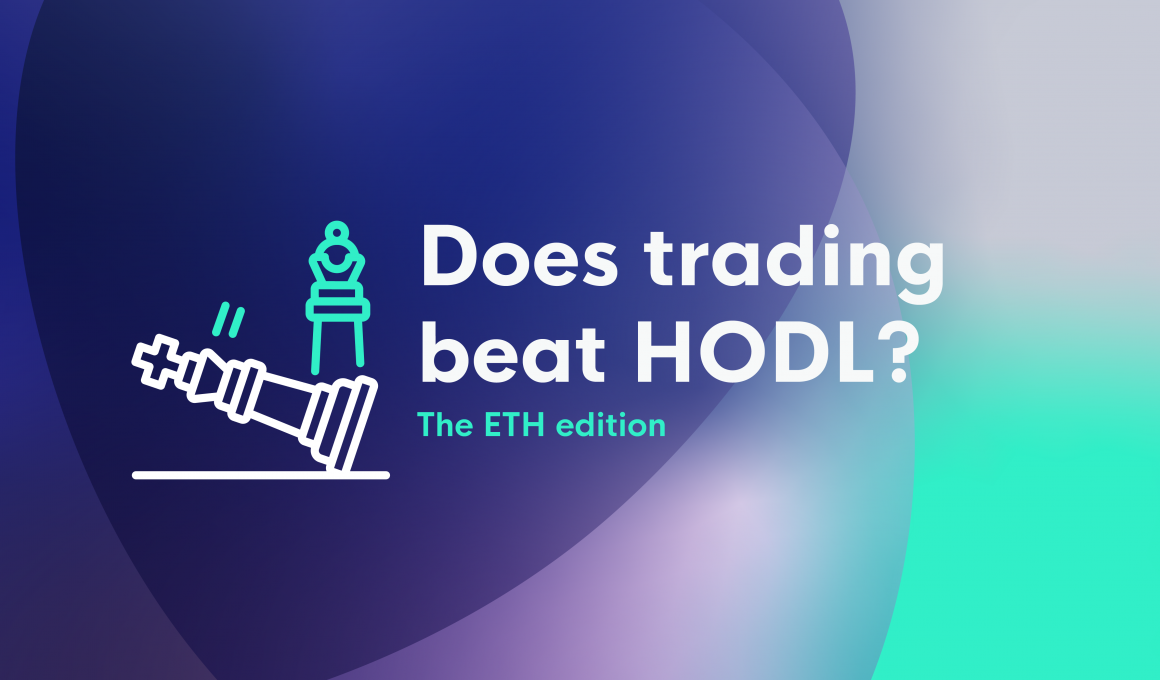To HODL or not to HODL, that is the question? Hold on for dear life (HODL), or trade speculatively . We’re back with another backtesting thought experiment. We all watched how Ethereum went on a very nice run since March 2020 yielding a total of 209% to holders. The DeFi craze and ETH 2.0 may be catalysts.
In August 90% of ETH holders were in profit. This brings up an interesting question: is it better to hold it or trade it? Trading is highly individual and has plenty of approaches so an absolute answer is impossible. However, we can explore some very common crypto trading strategies and see what might help you make the most out of a bull run. The similar experiment for trading Bitcoin during the 2017 bull run pinpointed some easy and profitable strategies. We hope to provide the same again.
The backtested strategies for trading ETH
⚠️ Disclaimer: As always, we need to remind that we are not fishing for the best crypto trading strategy or trading bot for Ethereum. Instead, we are investigating some popular indicators and trading strategies. The featured strategies are based on how these indicators are often applied, and benefit from hindsight bias. There are no stop losses or take profits. To make trading comparative to holding imagine you were basing your entire strategy on just one trading indicator initially.
All strategies were backtested 15 Mar 2020 – 15 Oct 2020 – a period of extremely aggressive growth. Holding Ethereum over the same period, would have yielded a 209% return. For comparison’s sake we’re trading using all funds on the account on every trade, which is not advisable in a real-life scenario. The backtested indicators are:
MACD
RSI
Bollinger Bands®
VWAP
HMA
EMA (50)
Here’s what we’ve found:
1. Trading Ethereum with MACD in 2020
MACD’s popularity is the biggest reason to watch it. Traders think that price will increase when MACD histogram turns green or crosses up 0. When MACD turns red or it’s crossing down 0, it’s expected for price to drop.

So, if you spent spring and summer of 2020 trading ETH like this on any of the 4 timeframes we tested, these are the results you could be expecting:
| Timeframe | Return |
| 1D | 43.27% |
| 4H | 127.43% |
| 1H | 102.79% |
| 30M | 76.92% |
While we see some great results on the medium timeframes none of them are beating HODL. The 4-hour timeframe shows some great promise but the benchmark that holding sets is still higher.
2.Trading Ethereum with RSI in 2020
Sticking to the classics, we’re continuing with RSI. Many traders tend to keep an eye on it, although its utility is sometimes challenged. The conventional trading strategy around it is: buy when it’s above 30 and sell when it reaches 70 or above.

The results seem quite consistent across timeframes with the 4-hours bringing in the best results. It’s clear that tracking conditions like overbought and oversold for Ethereum shows better results on higher timeframes, while the lower you go there is more noise.
| Timeframe | Return |
| 1D | 63.11% |
| 4H | 64.69% |
| 1H | 43.38% |
| 30M | 33.78% |
3.Trading Ethereum using Bollinger Bands® in 2020
Bollinger Band® is a mean reversion indicator. 2 standard deviation on both sides from a 20 period SMA represents area where approx. 90% of price action happens. So, when the price breaks out of this range, it is expected to return back to its mean. As volatility is high in crypto, the selected strategy tries to exploit both extremes by buying and selling when price is outside of the range. Alternately, you can open positions when price crosses the lower or higher bands and close it when it reaches the medium line, the 20-period moving average.

As volatility in crypto is massive, we see a very versatile performance across timeframes. While the 1-hour show potential, on its own this indicator does not overtake holding Ethereum.
| Timeframe | Return |
| 1D | 55.84% |
| 4H | 78.05% |
| 1H | 114.64% |
| 30M | 27.82% |
4.Trading Ethereum using VWAP in 2020
VWAP is quite a popular indicator particularly among equity traders. It delimits the average price and volume and shows if the current ones are above or below. Traders open long positions when price is crossing up the line and close it when price is crossing it down.

There are some strong results, particularly on the 1-day and 4-hour timeframes. However, VWAP in its naked form as an indicator that tends to measure “average” does not seem to beat holding in an exuberant crypto market.
| Timeframe | Return |
| 1D | 65.9% |
| 4H | 100.8% |
| 1H | 107.6% |
| 30M | 69.8% |
5.Trading Ethereum using HMA in 2020
Hull Moving Average is one of the quickest and most reactive moving averages, making it interesting to crypto traders. The trading strategy using it usually works like with any moving average: you open a position when price is crossing it up, and close it when price is crossing it down.

On high timeframes, particularly the 1-day the HMA performs well, but still HODL performs even better. The HMA seems less effective of low timeframes which could be due to its reactivity. Potentially optimizing this strategy could reveal some interesting results.
| Timeframe | Return |
| 1D | 121.42% |
| 4H | 69.54% |
| 1H | 34.28% |
| 30M | 12.95% |
6.Trading Ethereum using EMA (50) in 2020
The 50-period Exponential Moving Average is a reactive one and when viewed on the daily chat is one of the most used indicators of long-term trends. Again, this is a price crossing up/down strategy to open/close positions.

It’s quite startling to see how consistently the strategy performs across timeframes. Performance on the 1-hour timeframe is leading the rest.
| Timeframe | Return |
| 1D | 51.86% |
| 4H | 58.29% |
| 1H | 92.86% |
| 30M | 52.65% |
How to combine the well performing Ethereum crypto strategies to beat Buy-and-Hold
The first test is just the start. For a trading strategy that firmly beats Buy-and-Hold, let’s improve some of the better performing strategies.
Improving the basic Bollinger Bands® strategy
The most promising version of this strategy was the one tested on the 1-hour timeframe. It brought in profit of 107.6%. Just holding Ethereum yielded 209%. We need to check the statistics so we can start thinking about what to improve.

We are winning many more positions we are losing. This strategy is performing very well after all, but we are trying to beat Buy-and-Hold. It’s obvious that we hold the losing positions for much longer than the winning. So, we may look to add a confirmation on the close rule. This should reduce the number of positions overall. We are also looking to extend the amount of time that we have winning positions open.
As we are trading Ethereum it might be a good idea to include high Bitcoin dominance in the close rule. If Bitcoin is starting to dominate the total crypto market cap more, major altcoins may be depreciating. Let’s add Bitcoin dominance being above 64% vs the rest of the crypto market:

The results are in and yes, this new version of the basic Bollinger Bands® strategy does beat just buying and holding Ethereum:

To understand why we’ll go back to see our new statistics:

Indeed, we limited the number of positions, we are holding them all longer, but we managed to let our winners run. This is one of those desired strategies where there are many more winning positions, and they have a strong average net profit.
Conclusion
Some indicators are so popular that it seems that that traders use them as the end of all means. However, we see that single indicator strategies may not be the best way in terms of crafting a trading strategy for bull runs.
It’s possible to beat Buy-and-Hold
Yet it is possible to beat Buy-and-Hold. You need to be prepared and use the data that is at your disposal to create solid strategies. When you have a trading idea the first version is a first draft. The goal of a first draft is not to do it perfectly but to get it done. For even more ideas on how to start look at Dirk F. Gerritsen, et al., Finance Research Letters, where they evaluate multiple crypto trading strategies across a longer time span and compare them on a few interesting criteria including Sharpe ratio.
Furthermore, just because some strategy yields worse return than Buy-and-Hold during the biggest market growth, it doesn’t necessarily mean it’s worse. If you look at drawdowns you could see that B&H would have you lose tens of % points every other month. Some of these strategies might yield less but can also spare you these horrible drawdowns.
Bull-runs are not everything
We’re comparing the featured trading strategies to the biggest major asset bull-run of the year. If you extend the periods on which the trading strategies were backtested your perspective might shift.
For example, if we extend the testing period of the HMA 1D trading strategy to 1 year (15 Oct 2019 – 15 Oct 2020) it beats Buy-and-Hold by 20%:

The VWAP 4H strategy over 1 year blows Buy-and-Hold out of the water:

It yields +237% – more than double than the return of buying and holding.
As a trader you do not know how long a bull run will last for. You’ll need to deal with all sorts of markets and a solid trading strategy is what will give you an edge.
Confirmation indicators are important
We again saw the power of the simple confirmation indicator. While you may have something great it can often be made even better by adding volume, dominance, price above a moving average or anything else that can make your open or close conditions undeniable.
Feel free to jump on optimizing any of the mentioned strategies or one of your own.
Other crypto trading strategies
On more guidance on how to design great trading strategies check out our suggestions in this guide on what to look for and how to create a somewhat safe strategy. Our help center also has simple trading strategies to get you started.
If you want to see backtested versions head to the CLEO.one app where we feature free, already tested strategies. In fact, when you connect a Binance exchange account you can use CLEO.one for free! The account is packed with live trading bots, backtests, paper trading slots, and more!







